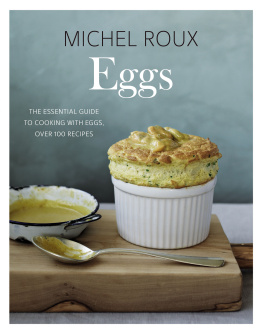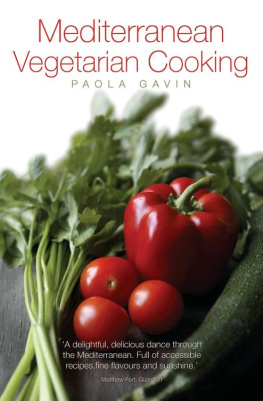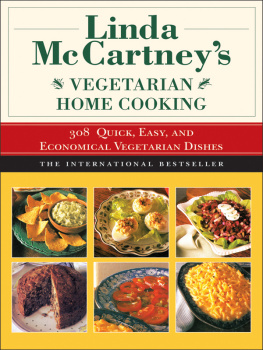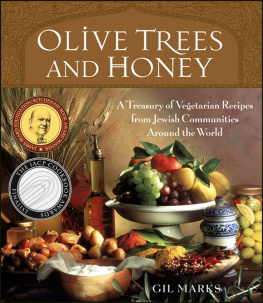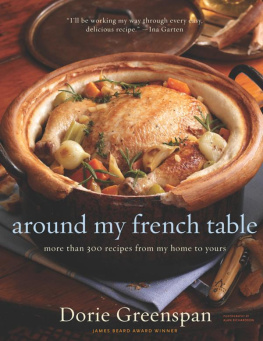THE REGIONS AND THEIR SPECIALTIES
In this chapter I have divided France into regions that roughly coincide with her historic provinces, with the exception of Gasgony and Guyenne, which I have subdivided and re-grouped according to their gastronomic similarities.
After each section I have given a list of local specialties, which are by no means definitivesuch a work would take a lifetime of researchwhich I hope will give the reader a fuller understanding of the great diversity of French vegetarian cooking. Many of these specialties have not been included in the recipe section of this book, where I have chosen dishes based entirely on my personal preference and taste, and on the simplicity of their preparation.
Picardy, Flanders, Artois
Picardy, Flanders, and Artois lie in the northeast corner of France, on the Belgian border, facing England across the Channel. These are the flatlands of the norththe most industrialized region of France, and the least inspiring. Picardy, perhaps more than its two neighbors, has retained its own customs, folklore, and cooking, with many vegetables dishes, cakes, and sweets that date back to the Middle Ages.
All kinds of vegetablesleeks, carrrots, peas, pumpkins, beans, and a wide variety of salad greensare grown in hortillonagesmarket gardens divided up by canals that can only be reached by punt. Many vegetable soups are made as well as vegetable or cheese tarts, which are called tartes, tourtes, flamiches, flamiques, or goyres.
Desserts are simple and rustic. Various fruit tarts and pies are made, usually with apple, pears, or rhubarb. Tarte lancienne is filled with a mixture of fromage blanc (fresh white cheese), egg yolks, and cream. Amiens is famous for its macaroons.
The cooking of Flanders is more Flemish than French. Flanders became French in 1668, when it was acquired by Louis XIV, (before then it was part of the Spanish Netherlands, which were ruled by the Hapsburgs).
Cumonsky called Flanders the country of brick and beer. Beer is often used in the cooking of Flandersflamiche au maroilles is a tart filled with Maroilles cheese, beer, eggs, and cream; petits lgumes la bire de garde is a dish of mixed vegetables simmered in beer, white wine, and herbs.
Cereals, sugar beets, and hops are widely grown. Cabbage and potatoes are favorite vegetables, and of course, the Belgian endive. Endive, or chicory, to use the original name, was first grown in Belgium in the middle of the nineteenth century, and was introduced to France some years later. However, by the end of the century the French were forced to use the same name endive, as the Belgians objected to the French using the same name. In Flanders, coffee is always served with the ground roots of dried chicory, which gives it its characteristic bitter taste.
Many cakes, pies, waffles, pancakes, and brioches are made, often with Flemish names. Koke-boteram, or Couque-bootram, is a large raisin brioche; crakinoskis la rhubarbe is a kind of pound cake topped with rhubarb. Pain dpice (spice bread) is said to have originated in Flanders during the time of the spice trade.
Artois is sandwiched between Picardy and Flanders, and has no coastline. It is a little hillier than its neighbors, and is sometimes called la petite Suisse (little Switzerland) by the locals.
Artois has few culinary traditions, although fine vegetables are grown around Saint-Omer. Like Flanders, Artois has a beer soup. The coeurs dArras are little spice cakes. Gateau dArtois is a puff pastry filled with crme ptissire. Craquelin is an oval-shaped brioche.
The cheeses of the north are strong: Maroilles, Rollot (a favorite of Louis XIV), and Gris de Lille, sometimes called Le Vieux Puant (the old stinker). La Boulette dAvesnes is a low-fat cheese seasoned with salt, pepper, crushed cloves, and fines herbes, and left to ripen for four months on windowsills or on special shelves nailed to window frames. The sunlight helps dry the cheese.
No wine is produced in the region. Besides beer, gin (genivre) is made, which is often added to a cup of coffee (lbistouille). Cider and poir (perry) are also made.
LOCAL SPECIALTIES
LE PAIN DAUSS or DAUSSADE.Chopped scallions and lettuce mixed with vinegar, cream, and coarse salt, served on slices of country bread.
SOUP DE BETTERAVES. Beetroot soup with onion and celery.
SOUP DES HORTILLONS. Vegetable soup with cabbage, leeks, potatoes, peas, lettuce, sorrel, and chervil.
SOUP DE FLANDRES. Pured vegetable soup made with potatoes, leeks, celeriac, and tomato, thickened with tapioca.
FLAMICHE AUX POIREAUX or FLAMIQUE PORIONS. Leek pie.
FLAMICHE AUX OIGNONS or FLAMIQUE LOIGNONS. Onion pie.
FLAMIQUE LCHTTROUILLE or TOURTE AU POTIRON.Pumpkin pie.
GOYRE DE VALENCIENNES. A Maroilles and fresh white cheese tart.
TARTE LA DJOTTE DE NIVELLES. Tart filled with beet greens, onions, and fresh white cheese.
TARTE AU MAROILLES. Maroilles cheese tart.
SOUFFL PICARD. Leek souffl.
HARICOTS BLANCS, SAUCE PICARDE. Dried white haricot beans simmered with onion and carrots, topped with a thick onion sauce.
ENDIVES AU GRATIN. Belgian endives topped with bchamel sauce and grated cheese and gratined.
GRATIN DE CHOUFLEUR PICARDE. Cauliflower topped with a thick onion sauce, breadcrumbs and melted butter and gratined in a hot oven.
POMMES DE TERRE DE DUNKERQUE. Parboiled potatoes, cut in half and deep-fried.
SALADE AMINOISE. Salad of Belgian endives, apples, lettuce, and walnuts.
GAUFRES AU POTIRON. Pumpkin waffles.
GALOPIAUX. Thick pancakes sprinkled with brown sugar.
GALOPINS. Thick pancakes made with bread or brioche.
GTEAU DE MERS. Apple cake topped with whipped cream.
RABOTTE PICARDE. An apple baked in puff pastrysimilar to the douillon of Normandy.
TARTE LPRONE or TARTE AUX PRUNEAUX. Prune tart.
ESKOUKEBAEKE. Large pancakes made with beer, served with honey or jam.
NIEULLES. Little flat cakes.
Normandy
The Normans are descendents of the Vikings, or Norsemen, who, in the latter part of the ninth century, plundered the valleys of Normandy almost as far as Paris. Eventually Charles the Simple (who was no fool) decided the only way to secure peace was to give the Vikings the land. So, in 911, their leader, Rollo, became the first Duke of Normandy.
The land is suprisingly varied, with long, sandy beaches near the fashionable resorts of Deauville and Le Touquet, the chalky cliffs of Etretatmirroring the white cliffs of Doverthe rocky headland of the Cotentin Peninsula, and the extraordinary Mont-St-Micheloften called the eighth wonder of the world. To the south and west lie the hilly peaks of the Norman Switzerland, and the beech forest of the bocage that stretches toward Brittany.
Normandy has been called the farm of France. It is one of the most prosperous of the French provinces; its wealth comes directly from the fertility of the land and its superior cattle. Norman cooking is based on dairy products; cream is lavished on everything and the butter of Isigny is only rivalled by the sweet butter of the Charente. Normandy cheese is world famousCamembert, Livarot, Pont-Lvque (known as the three graces),


